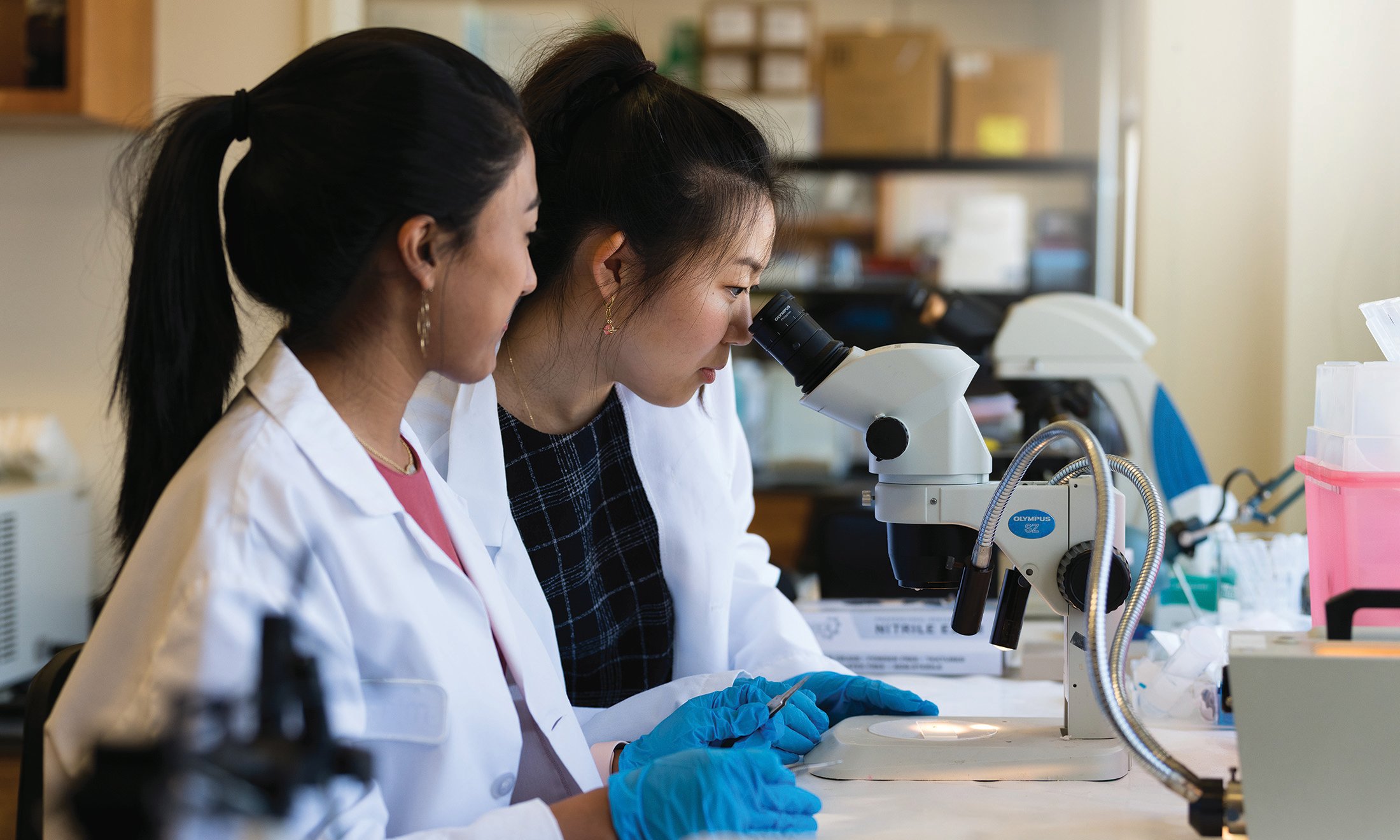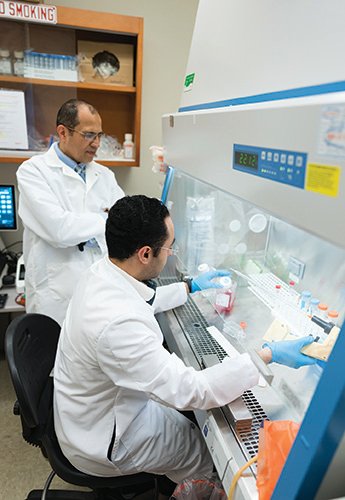The Future of Eye Research
Oakland University’s Eye Research Center is leading the charge in understanding eye diseases and discovering new treatments that could impact millions of people worldwide.

Min Young Kim, OUWB, School of Medicine (M2) and Suhani Gupta, OUWB, School of Medicine (M2). Photo credit: Rob Hall
If you or a loved one have experienced issues with your vision, you are not alone.
According to the Centers for Disease Control and Prevention, approximately 12 million people in the United States experience vision impairment and another 93 million adults are at high risk for serious vision loss. As the country’s population ages and the number of people diagnosed with diabetes and other chronic illnesses increases, it is estimated these numbers will double by 2030 unless corrective actions are taken.
The Oakland University William BeaumontEye Research Center(OUWB-ERC) is committed to advancing knowledge about common and rare conditions impacting eye health and discovering new treatments to improve the health and well-being of our communities.
Established in 2021, the OUWB-ERC leverages OU’s history of excellence in the study of eye disease and brings together departments, research institutes, laboratories and programs that share an interest in eye research to collaboratively expand this work into groundbreaking new areas.
Key to the Center’s mission is theEye Research Institute(ERI). For more than five decades, scientists at the ERI have successfully studied the underlying causes of many eye diseases that lead to vision loss and blindness. Their investigative work into illnesses such as macular degeneration, diabetic retinopathy and retinopathy in premature infants has earned the ERI worldwide recognition and support.
 |
| Mohamed Al-Shabrawey MBBCH (M.D.), M.Sc., Ph.D., Founding Director of the Eye Research Center with Mohamed Moustafa, M.S., Pharm D., Research Assistant |
As the founding director of the OUWB-ERC and the director of the ERI, Dr. Mohamed Al-Shabrawey, MBBCH (M.D.), M.Sc., Ph.D., is keenly focused on building collaborative relationships both within the university and beyond. The goal is to generate new and innovative ideas for eye research that are built on an interdisciplinary approach.
“Eye research is unique in that you need the skills of different disciplines and people to reach the highest levels of success,” he says.
Moving forward, the OUWB-ERC is working to integrate fields such as chemistry, neuroscience, computer science, public health and others into eye research to study not only the physical and functional aspects of the eye and eye diseases, but also the social, psychological and economic impacts these diseases pose for our community.
Al-Shabrawey shares a glimpse at one project currently in development, “We are starting a special collaborative program with the School of Engineering and Computer Science to implement artificial intelligence for low vision patients. Studies in this area could lead to new educational tools for blind children and technologies that enable visually impaired people to drive.”
除了研究本身,还有additional reasons to work collaboratively, according to Al-Shabrawey. “Interdisciplinary research programs are not only about generating new research ideas, but also creating a better network of professional relationships among people.” He believes as the OUWB-ERC’s network continues to expand, it will increasingly be recognized as a center for national and international collaborators and experts.
Furthermore, the OUWB-ERC’s long-term strategic goals include developing academic programming and upholding a rigorous training environment for students.
“It is important to pass on the knowledge,” says Al-Shabrawey. “At the core of any research is not only the professors or principal investigators, but also the undergraduate, graduate, and medical students and postdoctoral fellows who train in our labs. These students are our future scientists, and it is important to prepare them with the knowledge and skills they will need to continue the important work of discovery.”
Together, the concerted efforts of the OUWB-ERC to expand the field of eye research with new interdisciplinary ideas and a robust intellectual network all reach back to one main objective.
“The ultimate goal,” says Al-Shabrawey, “is to discover new ways to treat and prevent eye diseases and improve the quality of life for visually impaired people.”
Learn more about advances made by theEye Research Center.
 |
| Frank J. Gilpin, Ph.D. |
Frank J. Giblin, Ph.D., distinguished professor emeritus of biomedical sciences, conducted globally recognized studies on the lens and cataracts at the Eye Research Institute for more than 50 years and served as the Institute’s director for 17 years. His expertise and leadership helped establish OU as a world leader in eye research.
Upon retiring in 2021, he and his wife, Jane, made a generous gift to establish the Frank J. and Jane S. Giblin Endowed Research Professorship in Eye Research. This new endowment strengthens the university’s ability to attract high-caliber faculty and demonstrates the Giblins’ lifelong commitment to advancing vision research at OU.
“Dr. Giblin has made an important difference in building the eye research program that exists at Oakland University today,” says Al-Shabrawey. “The generous gift from him and his wife will ensure this important work continues for many years to come.”


 November 4, 2022
November 4, 2022 By Deborah Kiefer
By Deborah Kiefer

